I visited Vadnagar because of a photograph.
Yes, really. It was a random photograph that had popped up when I was browsing through an equally random photo-stream. The photograph was of a grand and towering toran or a decorative arch with the caption, “Kirti Toran, Vadnagar”.
My first reaction was where is Vadnagar? I mean, I knew that Vadnagar was in Gujarat and also that it was India’s Prime Minister Narendra Modi’s native town, but where was it? When a location search revealed that it was only about 40 km from Mehsana, I was stunned, for at that time, I was planning my North Gujarat trip in December 2014 at that time. And Mehsana was to be my base ! I took this happy coincidence as a sign that I needed to visit Vadnagar. 🙂
And visit I did, but without realising at that time that what I thought would be a quick trip to see the Kirti Torans would turn into something more.  In the weeks leading to my trip to North Gujarat, I tried to find some information on Vadnagar. What little I found was a revelation — for me at least. Let me summarise it in brief for you to give the context.
In the weeks leading to my trip to North Gujarat, I tried to find some information on Vadnagar. What little I found was a revelation — for me at least. Let me summarise it in brief for you to give the context.

 Vadnagar developed on the banks of the river Kapila, which also fed waters to a large lake called Sharmishtha; present day Vadnagar is on its banks. It was an important cultural centre that developed at the interface of Gujarat, Saurashtra, Malva and Rajputana regions.
Vadnagar developed on the banks of the river Kapila, which also fed waters to a large lake called Sharmishtha; present day Vadnagar is on its banks. It was an important cultural centre that developed at the interface of Gujarat, Saurashtra, Malva and Rajputana regions.
Archaeological evidence suggests that Vadnagar is over 4,000 years old and was, perhaps, a Harappan site.
But results are not conclusive as present day Vadnagar is built on layers and millennia of previous settlements making excavation a challenge.
Over the milliennia and centuries, Vadnagar has also gone through name changes from Chamatkarpur to Anartapur (as per references in the Mahabharata) to Anandpura (from the records of the Chinese traveller, Hiuen Tsang) to its present name.  A centre for three major religions — Buddhism, Jainism and Hinduism — Vadnagar was also a key manufacturing and trading hub making it a very prosperous city. This attracted foreigners like the Greeks and invaders like the rulers of Malva, the Delhi Sultanate and the Mughals.
A centre for three major religions — Buddhism, Jainism and Hinduism — Vadnagar was also a key manufacturing and trading hub making it a very prosperous city. This attracted foreigners like the Greeks and invaders like the rulers of Malva, the Delhi Sultanate and the Mughals.
Vadnagar reached its creative and artistic peak during the reign of the Solanki Dynasty, and that time period is often referred to as its golden period. It was during this dynasty’s rule that the city’s fort (which no longer exists) and its 6 gates were strengthened, and many temples, palaces, residences, markets, and public amenities like wells, public baths, roads, and inns in and around the city were constructed.
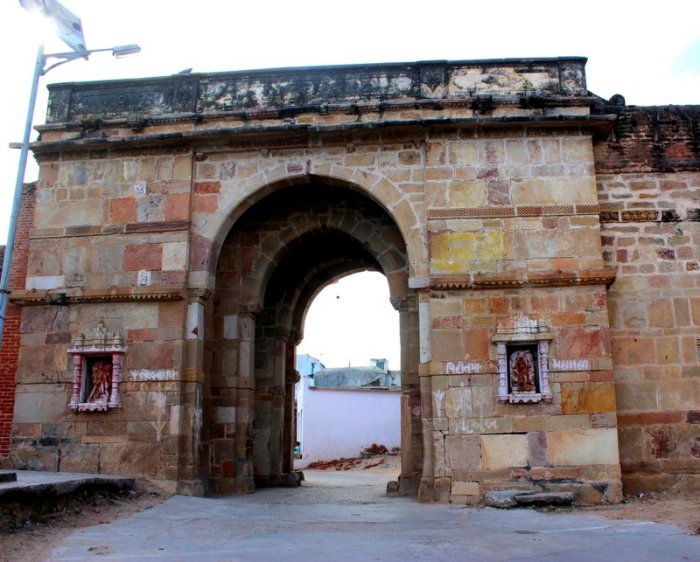
It was to see these historical remains and connect with some associated myths and legends that I made my way to Vadnagar in the afternoon of my last day in North Gujarat, after a visit to Modhera. A bus from Mehsana to Visnagar, and then another to Vadnagar saw me arrive in the town at around 2.30 in the afternoon. A quick lunch at a dhaba near the bus stand and I was all set to explore Vadnagar in a rickshaw that I hired for the afternoon.
My first halt was at the memorial of Tana and Riri, two sisters who were supposed to have taught Tansen, the great singer of the Mughal Court, Raga Malhar. I’m ashamed to admit that, in spite of having learnt music, I knew nothing of the legend of Tana and Riri.
According to the legend (do read the full story here), the sisters had requested Tansen never reveal to others as to who had taught him Malhar. But the Mughal Emperor Akbar somehow found out about this and wanted the sisters in his court. Because the sisters refused, the Mughal army was sent to Vadnagar to capture them. Instead of giving in, Tana and Riri preferred to commit suicide. The whole town mourned the loss of the sisters and a memorial was built in their honour. The Tana-Riri Memorial is set in a beautiful garden and is the venue for the annual music festival held at Vadnagar in their memory. One thing is for sure. Henceforth, Malhar will always be Tana-Riri ki Malhar, instead of Miyan ka Malhar.

The 10th century Amter Mata Temple was the next place I visited. The entrance to the temple came as a bit of a surprise — not only did it look like an old-fashioned shop entrance, it had some distinctly art deco elements as part of its façade.
 This was not a 10th century design, but obviously something more modern and sure enough the information board available inside said the temple had undergone several alterations and reconstructions over the centuries.
This was not a 10th century design, but obviously something more modern and sure enough the information board available inside said the temple had undergone several alterations and reconstructions over the centuries.
From the style, it looked like the present structure was about 80-100 years old. The door opened into a large courtyard with the art deco design continuing. The main shrine was to one side and locked.
Apart from a man sweeping the courtyard, there was no one else. Behind the shrine were remnants of older, much older shrines and which were probably original too. Sculptures, which also looked like part of the original temple, were placed behind the new main shrine.
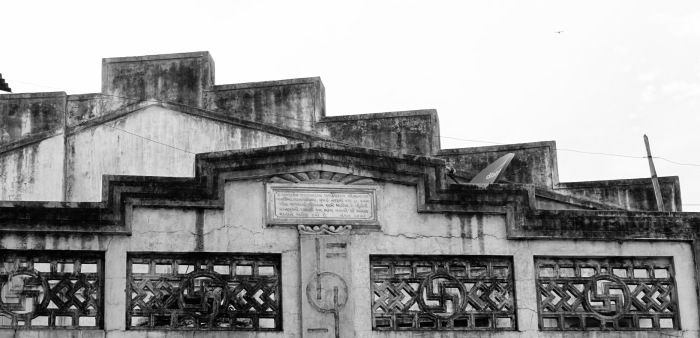
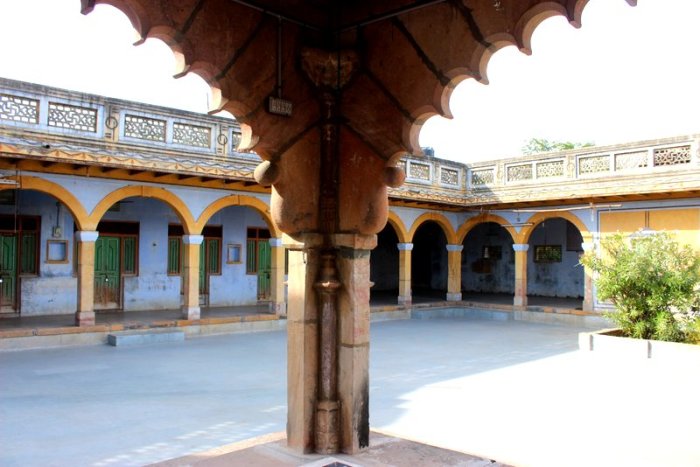
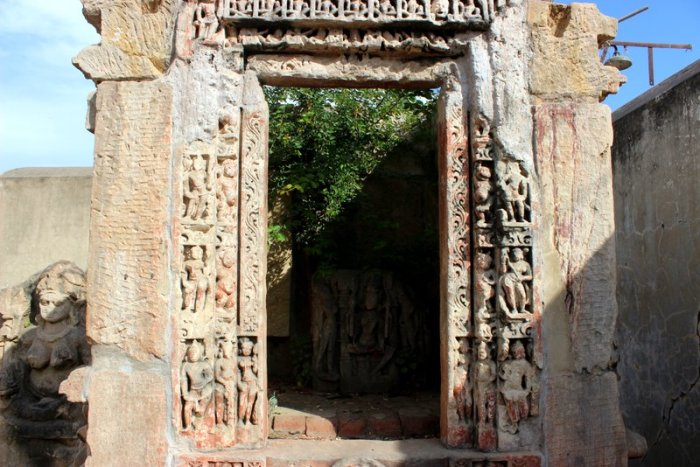

 The Hatkeshwar Mahadev Temple is another ancient temple in Vadnagar and we headed there next. Though the existing temple was constructed in the 13th century (some versions say 17th century) it is believed that a temple existed at this site from before the times of the Mahabharata.
The Hatkeshwar Mahadev Temple is another ancient temple in Vadnagar and we headed there next. Though the existing temple was constructed in the 13th century (some versions say 17th century) it is believed that a temple existed at this site from before the times of the Mahabharata.
Additional structures have also been added in recent years like the current entrance to the temple, which has art deco elements. The temple appeared to be undergoing another round of alteration as there were repairs and renovation work happening. There garbha griha is several feet below ground level and only the top portion of the lingam is visible.
According to mythology, this lingam extends for an infinite distance below the ground as a column of fire and its exposed part is warm to the touch. I wasn’t allowed to verify this, though.

The Kirti Toran — yes, the one that I saw in the photograph — is the next site visited. There were surprises awaiting me there as well: its located in the middle of a housing colony; the size; and the fact that there were two torans !
According to the information board there, the torans were built in the 12th century and stood at the northern and eastern entrances of a great temple (similar to the Rudra Mahalaya), which no longer exists. Both the torans are made of sandstone and have been built without mortar and cementing material with a base of 2.5 sq.m. to give the pillars stability.
To say that the torans are stunning is a bit of an understatement and also stating the obvious, but even after having seen similar torans, the grandeur left me awestruck. The design and carvings were similar to the ones I saw at the Rudra Mahalaya and also the Sun Temple at Modhera.

As we left the toran site, Dashrath bhai, the rickshaw driver, asked me if I’d like to see a Vav or a Stepwell. Of course, I said yes and that’s where we went next. The vav is on private land and initially, I was reluctant to go in, but Dashrath bhai assured me that it was alright and that the owners would not mind.
I found the vav in such a state of precarious ruin and overrun with aggressive langurs that I couldn’t get too close to it. All the pictures were taken with a zoom lens. From what I could make out, the design was similar to Rani ni Vav, in the sense that the well shaft was at one end and the steps at the other; the scale though was much smaller and not too deep for groundwater levels in Vadnagar are quite shallow. The vav must have been quite beautiful in its original state as the remnants of sculptures and carvings revealed. The well had water in it as was evident from the pipes leading going from the well to the small farm surrounding it. I’m not sure if the vav was always on private land, or if had been a common resource in the distant past.


The last place that I visited was Saptarshi, which, according to local belief was where the great sage and vedic scholar Yagyavalkya had his ashram. Today, Saptarshi is a set of ruins surrounding a pond that lies east of the Sharmishtha lake.
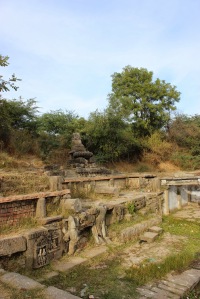 The place is quite a sight, especially if, like me, you love ruins. There are pillared structures standing, barely; steps leading to the edge of the pond, which on closer examination reveal carvings; shrines on the pond edge, and panels upon panels of carvings surrounding the pond.
The place is quite a sight, especially if, like me, you love ruins. There are pillared structures standing, barely; steps leading to the edge of the pond, which on closer examination reveal carvings; shrines on the pond edge, and panels upon panels of carvings surrounding the pond.
Not all of it is accessible, though. Most of the panels are of sculptures in a meditative post. There were lots of sages in those, some figures with disfigured faces, and also a Ganesha. The most interesting, and not to mention surprising, find was that of a woman sage among all the sculpted figures.
This was the first time I was coming across a depiction of a woman sage in art. I wondered if it was Maitreyi, one of Yagyavalkya’s wife and a great scholar herself.

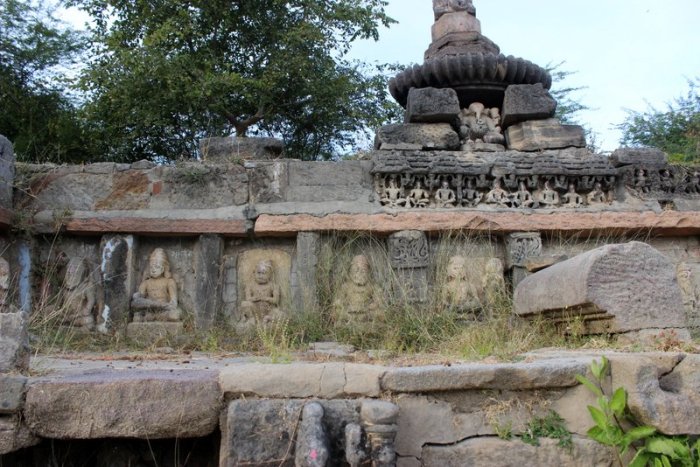
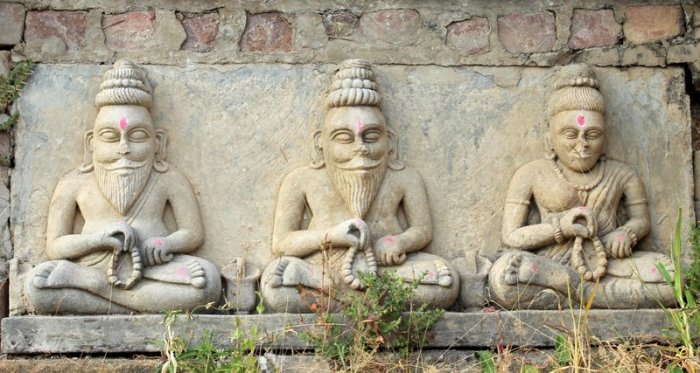
The Saptarshi pond itself was quite beautiful. Green, calm and surrounded by trees on all sides, it had lotus flowers blooming on one side and lots of birds on the other side. Quite a magical sight it was, and serene too.  I was quite amazed by the numerous water bodies at Vadnagar. Apart from Sharmishtha, which is the largest and most distinctive, I saw smaller ponds and pools of varying sizes, as I made my way through Vadnagar. And all the water bodies, without exception were full of birds, none that I could identify though. Dashrath bhai said that many birds arrived in winters and stayed on till the onset of summer in Vadnagar. When he said that I remembered the relief panels of birds carved on all the city gates. Was this a way to acknowledge the rich bird life in the city? I wondered.
I was quite amazed by the numerous water bodies at Vadnagar. Apart from Sharmishtha, which is the largest and most distinctive, I saw smaller ponds and pools of varying sizes, as I made my way through Vadnagar. And all the water bodies, without exception were full of birds, none that I could identify though. Dashrath bhai said that many birds arrived in winters and stayed on till the onset of summer in Vadnagar. When he said that I remembered the relief panels of birds carved on all the city gates. Was this a way to acknowledge the rich bird life in the city? I wondered.
 Though I very much wanted to, I didn’t have the opportunity or the time to wander through Vadnagar on foot, especially the walled portion. I had to be content with seeing whatever I could from the rickshaw — narrow streets and houses close to each other broken up with small community spaces; elderly people seated at the entrance of their brightly coloured doors and houses and watching people go by; architectural styles of the houses — quite a lot of the houses had art deco elements.
Though I very much wanted to, I didn’t have the opportunity or the time to wander through Vadnagar on foot, especially the walled portion. I had to be content with seeing whatever I could from the rickshaw — narrow streets and houses close to each other broken up with small community spaces; elderly people seated at the entrance of their brightly coloured doors and houses and watching people go by; architectural styles of the houses — quite a lot of the houses had art deco elements.
Together with traditional architecture, some colonial as well as contemporary styles, Vadnagar has a delicious mixture of architectural styles and one that I would have loved to explore, along with its more recent history. But it was already 5 pm and I had to return to Mehsana in order to board my train to Mumbai.
Vadnagar was the surprise element and the highlight of my trip. The best was really saved for the last. Little did I know when I stepped off the bus at Vadnagar that in the space of a couple of hours I would be time travelling through history, myths and legends that left me just breathless with delight. Vadnagar was a discovery in every sense for me, and I hope it was for you too.
And to think it was a photograph of a toran that sent me to Vadnagar ! 😀
North Gujarat Series: Rani ni Vav | The Sahastralinga Talav | The Vohrawads of Sidhpur | The Rudra Mahalaya Temple I Ambaji | The Sun Temple of Modhera
Notes:
- Please do read this this amazingly detailed blog on Vadnagar that I came across.
- if you are interested in knowing more about the birds of Vadnagar, then please do read this post by R. Gajjar.
- Though I was based in Mehsana, you can easily visit Vadnagar as a day trip from Ahmedabad.
- If you require any further information or assistance in planning a trip to this region, please feel free to write to me as a comment or through the Contact page of the blog.

Lovely article and pictures too.
LikeLiked by 1 person
Thank you very much, Aadil. I had something else in mind when I started writing this post on Vadnagar. Like most of my posts, it had a mind of its own and the result was this. 🙂
LikeLiked by 1 person
Have a mental note of visiting this place…
LikeLiked by 1 person
Vadnagar is a photographer’s delight and I kept getting distracted all the time. In retrospect, the few hours I spent there were too little, but I’m glad that I did visit Vadnagar.
LikeLike
Superb!!! really beautiful, Sudha! and so much I didnt know at all… to begin with , i had no idea Vadnagar had such an interesting history, or that there was so much of it still standing. hope i can go there someday and see it for myself//
LikeLiked by 1 person
Thank you, Anuradha. I have only scratched the surface of Vadnagar for I’m pretty sure there are many interesting things in the town. Its modern history is interesting too with educationists and social workers having contributed to the growth of Vadnagar. And the Buddhist site ! I’m waiting for the time it will be thrown open to the public. 🙂
LikeLike
Such a wonderful place with loads of interesting architectures. Glad to know about it. Nice post.
LikeLiked by 1 person
Thanks, Niranjan. Hope this means that you have added Vadnagar to the list of places to visit 🙂
LikeLike
Really a Nice Post…Well narrated thru’ Pictures!
LikeLiked by 1 person
Welcome here, Sreedhar Bhattaram. Thank you so much for stopping by and sharing your appreciation of this post. Do keep visiting. 🙂
LikeLike
Good information to know and right to the point. Nice photos also. Thanks for this well written post, i’ll follow up for more updates.
LikeLiked by 1 person
Thank you very much, Ivy. Very nice of you to stop by and leave a comment. Hope you’ll keep visiting.
LikeLike
Love your blog. I’ve recently returned from Gujarat and missed out on Vadnagar – went to Baroda instead. Good excuse to return soon !
Thanks again,
-Kevin.
LikeLiked by 1 person
A very warm welcome to “My Favourite things”, Kevin. Thank you so much for your words of appreciation. North Gujarat has a lot to offer and I feel that I have just skimmed the surface. Many more trips have to be made there !
I saw the photographs from your Gujarat trip and they are awesome, especially the Modhera ones. Following your blog now 🙂
LikeLike
Reading your blog after a long interval. Vadnagar is truly amazing and yes I loved the toran. The details on the panels near the pond are beautiful. It is remarkable that the six city gates are still surviving. As alwaysl all the pictures are beautifully captured by you.
LikeLiked by 1 person
Why have you been neglecting my blog, Neena ? 😥
Vadnagar is, perhaps, Gujarat’s best kept secret. And I’m surprised that in spite of NaMo being from there, tourism hasn’t really taken off.
LikeLike
A very interesting travelogue! I had heard only of the Tana-Riri memorial, everything else about Vadnagar was new to me 🙂 I’ll make sure to include it in my plans whenever I get a chance to visit Gujarat next. Lovely pictures, too!
LikeLiked by 1 person
Hello Ami. Welcome to my blog and thank you so much for stopping by and commenting. You at least knew about the Tana Riri memorial. For me everything was new. And if you’re going to Vadnagar, you might want to visit Idar and Vijaynagar as well. I haven’t been there, but I’ve heard that it is a fascinating place to visit.
Do keep visiting.
LikeLiked by 1 person
Made a note of Idar and Vijaynagar too – thank you. 🙂
LikeLike
Nice Blog!! this was Quite Detailed one . Really Enjoyed reading this blog and this urges me to return back to Gujarat Soon . I visiting Gujarat in feb and spent time in Ahmedabad,Bhuj ,Kutch. Loved the stay there .
i did not not know about Vadnagar .
Still Lot to explore in Gujarat So Vadnagar would be in top of my list .
LikeLiked by 1 person
Welcome here, Arun and thank you so much for stopping by and commenting. I visited Kutch in 1992 and it is time for me to go back there again. If you are going to Vadnagar, you might want to visit Idar as well. I’ve heard that it is a fabulous place to visit.
LikeLike
I have been to Vadnagar many times before but I have never quite seen it the way this blog post portrays it. The writer has done a tremendous job on trying to explain in detail about the place and the pictures posted speak for it self. A terrific read indeed!
LikeLiked by 1 person
Hello Anup. Thank you for visiting my blog and taking the time to share your appreciation of my post. 🙂
LikeLike
Wow what an amazing place, very well written along with great pictures you surely took me back in time. I recently came across your blog and really loving it a lot. Thanks for sharing looking forward to more such historical time travel trips with you.
LikeLike
Thanks, Pradeep for stopping by and sharing your appreciation of this blog post. 🙂
LikeLike
Reblogged this on oshriradhekrishnabole.
LikeLike
Thank you for reblogging and sharing on your blog. 🙂
LikeLiked by 1 person
What a surprising details!!!. I worked as an engineer of Dharoi Project in this town almost 4 years, we knew this town for its under developement and low educationan and as a town of low income communities. In seventy’s I saw diffrent pictures during night walking from railway station to inside ,my friend were advising me not to walk during night!!! . I preferred to live nearby town VISNAGAR. This town is waiting for better rail service when Mr Modi is PM. I love this town and like to visit when I am visiting India .– Raman Patel (CHICAGO)
LikeLike
Gujarat is a treasure trove for travel seekers. Vadnagar, with a lake on my name, had always beckoned me. But even after multiple visits to Gujarat, I could not make out 😦 Your story took me through. Hope to have my own story next. I have few of my Gujarat experiences in my blog 🙂
LikeLike
Welcome here, FootlooseinMe. Thank you so much for stopping by and commenting. Gujarat is a fascinating place and I have a love hate relationship with it. I have lived here, travelled here, studies here and now blogged about it as well.
I hope you get to visit Vadnagar soom and also meet your namesake. 🙂
LikeLiked by 1 person
Nice.
Thanks for giving credits to our two blogs: vadnagar.blogspot.com and birdsofvadnagar.blogspot.com through your Notes. We are glad to note that the information given in these two blogs is well used and presented by you.
We didn’t know that one of the images in the carved stone panel of the Sages at Saptarshi depicts a female and most likely it is that of none but the great sage Yagyavalkya’s wife learned Maitreyi. Great observation indeed. You rightly deserve congratulations. Can we please use this information to make our “Vadnagar -an ancient city” writeup richer? We shall be very thankful to you if you kindly permit us to do so by writing to us at our email address: vadnagar@gmail.com.
Any attempt to throw more light on the interesting past of Vadnagar is appreciable. Please keep up the good work.
With best wishes,
Harjivan Suthar.
LikeLike
Welcome to my blog, Harjivan and thank you so much for stopping by and commenting. Both your blogs were of great use to me when I wrote them. You are most welcome to use the image and the accompanying write-up as long as due credit is given to the source.
LikeLike